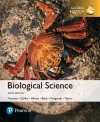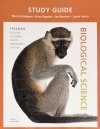About this book
Scott Freeman's Biological Science is beloved for its narrative style, its emphasis on experimental evidence, and its dedication to active learning. Science education research indicates that true mastery of content requires a move away from memorization towards active engagement with the material in a focused, personal way. Biological Science is designed to equip students with strategies to assess their level of understanding and identify the types of cognitive skills that need improvement.
With the Sixth Edition, content has been streamlined with an emphasis on core concepts and core competencies from the Vision and Change in Undergraduate Biology Education report. The text's unique BioSkills section is now placed after Chapter 1 to help students develop key skills needed to become a scientist, new "Making Models" boxes guide learners in interpreting and creating models, and new "Put It all Together" case studies conclude each chapter and help students see connections between chapter content and current, real-world research questions. New, engaging content includes updated coverage of global climate change, advances in genomic editing, and recent insights into the evolution of land plants.
Contents
1. Biology and the Tree of Life
BioSkills
I. THE MOLECULAR ORGIN AND EVOLUTION OF LIFE
2. Water and Carbon: The Chemical Basis of Life
3. Protein Structure and Function
4. Nucleic Acids and the RNA World
5. An Introduction to Carbohydrates
6. Lipids, Membranes, and the First Cells
II. CELL STRUCTURE AND FUNCTION
7. Inside the Cell
8. Energy and Enzymes: An Introduction to Metabolism
9. Cellular Respiration and Fermentation
10. Photosynthesis
11. Cell-Cell Interactions
12. The Cell Cycle
III. GENE STRUCTURE AND EXPRESSION
13. Meiosis
14. Mendel and the Gene
15. DNA and the Gene: Synthesis and Repair
16. How Genes Work
17. Transcription, RNA Processing, and Translation
18. Control of Gene Expression in Bacteria
19. Control of Gene Expression in Eukaryotes
20. The Molecular Revolution: Biotechnology and Beyond
21. Genes, Development, and Evolution
IV. EVOLUTIONARY PATTERNS AND PROCESSES
22. Evolution by Natural Selection
23. Evolutionary Processes
24. Speciation
25. Phylogenies and the History of Life
V. THE DIVERSIFICATION OF LIFE
26. Bacteria and Archaea
27. Protists
28. Green Algae and Land Plants
29. Fungi
30. An Introduction to Animals
31. Protostome Animals
32. Deuterostome Animals
33. Viruses
VI. HOW PLANTS WORK
34. Plant Form and Function
35. Water and Sugar Transport in Plants
36. Plant Nutrition
37. Plant Sensory Systems, Signals, and Responses
38. Plant Reproduction and Development
VII. HOW ANIMALS WORK
39. Animal Form and Function
40. Water and Electrolyte Balance in Animals
41. Animal Nutrition
42. Gas Exchange and Circulation
43. Animal Nervous Systems
44. Animal Sensory Systems
45 Animal Movement
46. Chemical Signals in Animals
47. Animal Reproduction and Development
48. The Immune System in Animals
VIII. ECOLOGY
49. An Introduction to Ecology
50. Behavioral Ecology
51. Population Ecology
52. Community Ecology
53. Ecosystems and Global Ecology
54. Biodiversity and Conservation Biology
Customer Reviews
Biography
Scott Freeman received his Ph.D. in Zoology from the University of Washington and was subsequently awarded an Alfred P. Sloan Postdoctoral Fellowship in Molecular Evolution at Princeton University. His current research focuses on the scholarship of teaching and learning and he recently published two papers on his work: (1) how active learning and peer teaching techniques increase student learning and improve performance in introductory biology (Freeman, S., E. O'Connor, J.W. Parks, M. Cunningham, D. Hurley, D. Haak, C. Dirks, and M.P. Wenderoth. 2007. Prescribed active learning increases performance in introductory biology. CBE-Life Sciences Education 6: 132-139.); and (2) how the levels of exam questions vary among introductory biology courses, standardized post-graduate entrance exams, and professional school courses (Zheng, A.Y., J.K. Lawhorn, T. Lumley, and S. Freeman. 2007. Applications of Bloom's Taxonomy Debunks the "MCAT Myth." Science, 25 January 2008: 414-415).
Kim Quillin, combines expertise in biology and information design to create lucid visual representations of biological principles. She received her B.A. in Biology at Oberlin College and her Ph.D. in Integrative Biology from the University of California, Berkeley (as a National Science Foundation Graduate Fellow), and has taught undergraduate biology at both schools. Students and instructors alike have praised Kim's illustration programs for Biological Science, as well as Biology: A Guide to the Natural World, by David Krogh, and Biology: Science for Life, by Colleen Belk and Virginia Borden, for their success at the visual communication of biology. Kim is a lecturer in the Department of Biological Sciences at Salisbury University.



































![The Nature and Properties of Soils [Global Edition]](http://mediacdn.nhbs.com/jackets/jackets_resizer_medium/22/229384.jpg?height=150&width=116)

